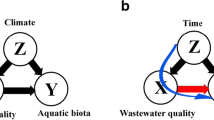Abstract
In recent years, there has been a boom in environmental assessment reports utilizing environmental indicators. Most of these publications are based on the casual chain frameworks (e.g., Pressure–State–Response (PSR), Driving force–State–Response (DSR), and Driving force–Pressure–State–Impact–Response (DPSIR)). These frameworks have made an important contribution by emphasising the importance of causality. However, the reliance on simple uni-directional chains is at the same time not very conducive to a good understanding of the complexity of the processes behind environmental indicators. This limits the usefulness of these frameworks for environmental (impact) assessments. In this paper we propose an enhanced DPSIR (eDPSIR) framework for environmental indicators that takes inter-relations of indicators into account by relying on the use of causal networks rather than causal chains. It will be shown how the concept of causal networks can increase insight into the inter-relation of environmental issues and associated indicators, can facilitate the identification of key indicators for particular kinds of questions, and can provide a useful first step to the establishment of dose–response functions. Working with causal networks can contribute to more appropriate environmental policies and better management decisions.
Similar content being viewed by others
Abbreviations
- DPSIR:
-
Driving force–Pressure–State–Impact–Response
- DSR:
-
Driving force–State–Response
- eDPSIR:
-
enhanced DPSIR framework
- EEA:
-
European Environment Agency
- OECD:
-
Organisation for Economic Co-operation and Development
- PSR:
-
Pressure–State–Response
References
Bakkes, J.A., van den Born, G.J., Helder, J.C., Swart, R.J., Hope, C.W., & Parker, J.D.E. (1994). An overview of environmental indicators: State of the art and perspectives, Report nr UNEP/EATR.94-01;RIVM/.402001001. Nairobi/Bilthoven: UNEP/RIVM.
Dale, V.H., & Beyeler, S.C. (2001). Challenges in the development and use of ecological indicators. Ecological Indicators, 1, 3–10.
EEA (1999). Environment in the European Union at the turn of the century, Report nr 2. Copenhagen: European Environment Agency.
EEA (2000). Environmental signals 2000, Report nr 6. Copenhagen: European Environment Agency.
EEA (2001). Environmental signals 2001, Report nr 8. Copenhagen: European Environment Agency.
EPA (2003). Draft report on the environment 2003, Report nr EPA 260-R-02-006. Washington, D.C.: United States Environmental Protection Agency.
Esty, D.C., Levy, M., Srebotnjak, T., & de Sherbinin, A. (2005) 2005 Environmental sustainability index: Benchmarking national environmental stewardship. Davos: Yale Center for Environmental Law and Policy & Center for International Earth Science Information Network.
Fehr, M., Sousa, K.A., Pereira, A.F.N., & Pelizer, L.C. (2004). Proposal of indicators to assess urban sustainability in Brazil. Environment, Development and Sustainability, 6, 355–366.
Hammond, A., Adriaanse, A., Rodenburg, E., Bryant, D., & Woodward, R. (1995). Environmental indicators: A systematic approach to measuring and reporting on environmental policy performance in the context of sustainable development. Washington, D.C.: World Resources Institute.
Jackson, L.E., Kurtz, J.C., & Fisher, W.S. (2000). Evaluation guidelines for ecological indicators, Report nr EPA/620/R-99/005. Washington, D.C.: Environmental Protection Agency.
Kay, D., Prüss, A., & Covalán, C. (2000). Methodology for assessment of environmental burden of disease. Geneva: World Health Organization.
McRae, T., Smith, C.A.S., & Gregorich, L.J. (2000). Environmental sustainability of canadian agriculture: report of the agri-environmental indicator project. Ottawa, Ontario: Agriculture and Agri-Food Canada.
NCSSF (2005). Science, biodiversity, and sustainable forestry: A findings report of the National Commission on Science for Sustainable Forestry. Washington, DC: National Commission on Science for Sustainable Forestry.
Niemeijer, D. (2001). Assessing environmental sustainability: Process-based models versus state indicators. Paper presented at the 97th Annual Meeting of the Association of American Geographers, 27 February to 3 March 2001, New York, USA.
Niemeijer, D., & de Groot, R. (in review). A conceptual framework for selecting environmental indicator sets. Ecological Indicators (submitted).
NRC (2000). Ecological indicators for the nation (180 pp.). Washington, D.C.: National Academy Press.
Odum, E.P. (1953). Fundamentals of ecology (384 pp.). Philadelphia: Saunders.
OECD (1993). OECD Core set of indicators for environmental performance reviews: A synthesis report by the Group on the State of the Environment, Report nr 83. Paris: Organisation for Economic Co-operation and Development.
OECD (1998). Towards sustainable development: Environmental indicators. Paris: Organisation for Economic Co-operation and Development.
OECD 1999a, Environmental indicators for agriculture: Volume 1 concepts and frameworks. Paris: Organisation for Economic Co-operation and Development.
OECD 1999b, Environmental indicators for agriculture: Volume 2 issues and design, the York workshop. Paris: Organisation for Economic Co-operation and Development.
OECD 2001a, Environmental indicators for agriculture: Volume 3 methods and results. Paris: Organisation for Economic Co-operation and Development.
OECD 2001b, OECD environmental indicators: Towards sustainable development. Paris: Organisation for Economic Co-operation and Development.
Perl, J. (2001). Bayesian Networks, Causal Inference and Knowledge Discovery. http://www.secondmoment.org.
Slocombe, D.S. (1998). Forum: Defining goals and criteria for ecosystem-based management. Environmental Management, 22, 483–493.
Smeets, E., & Weterings, R. (1999). Environmental indicators: Typology and overview, Report nr 25. Copenhagen: European Environment Agency.
Swart, R.J., Bakkes, J.A., Niessen, L.W., Rotmans, J., de Vries, H.J.M., & Weterings, R. (1995). Scanning the global environment: A framework and methodology for integrated environmental reporting and assessment, Report nr 402001002. Bilthoven: RIVM.
The Heinz Center (2002). The state of the nation’s ecosystems: measuring the lands, waters, and living resources of the United States. Washington, DC: The H. John Heinz III Center for Science, Economics, and the Environment.
UNEP (2002). Global environment outlook 3. Nairobi: United Nations Environment Programme.
Wascher, D.M. (2000). Agri-environmental indicators for sustainable agriculture in Europe. Tilburg: European Centre for Nature Conservation.
World Resources Institute (2005). World Resources 2005: The wealth of the poor, managing ecosystems to fight poverty. Washington, DC: World Resources Institute.
Acknowledgements
The research for this paper was carried out as part of the “Development of ecological indicators for sustainable food production” project of the PROFETAS (Protein Foods, Environment, Technology And Society) research program funded by the Netherlands Organization for Scientific Research (NWO). The authors would like to thank Harry Aiking and the anonymous reviewers for their useful comments on early versions of this paper.
Author information
Authors and Affiliations
Corresponding author
Rights and permissions
About this article
Cite this article
Niemeijer, D., de Groot, R.S. Framing environmental indicators: moving from causal chains to causal networks. Environ Dev Sustain 10, 89–106 (2008). https://doi.org/10.1007/s10668-006-9040-9
Received:
Accepted:
Published:
Issue Date:
DOI: https://doi.org/10.1007/s10668-006-9040-9




